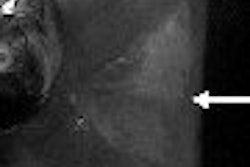As multidetector CT scanners have added detector rows over the years, faster and faster heart rates have been required to cause motion artifacts significant enough to reduce the diagnostic accuracy of coronary CT angiography (CTA). The routine administration of beta-blockers to slow heart rates can help make more patients eligible for the procedure.
While four-slice CT scanners were limited to heart rates less than 75 bpm, 64-detector-row scanners have been shown to produce diagnostic images over a wide range of heart rates, though image quality still decreases with increasing heart rates.
What about dual-source scanners? "The results of preliminary studies have shown that the quality of images obtained with dual-source CT coronary angiography at a relatively high mean heart rate is sufficient for diagnosis," wrote Drs. David Matt, Hans Scheffel, Sebastian Leschka, Thomas Flohr, and colleagues from University Hospital Zurich in Switzerland; Siemens Medical Solutions in Erlangen, Germany; and the Zurich Center for Integrative Human Physiology.
"Moreover an early experience showed that compared with invasive coronary angiography, dual-source CT coronary angiography had high diagnostic accuracy in the diagnosis of substantial coronary artery stenosis in a patient population whose heart rates were not controlled," they wrote (American Journal of Roentgenology, September 2007, Vol. 189:3, pp. 567-573).
With this study, the authors sought a systematic evaluation of the relationship between mean heart rate and heart rate variability during scanning with dual-source CT, characterized by two x-ray tubes and two corresponding detectors mounted on a gantry with an angular offset of 90° (Somatom Definition, Siemens).
The research team performed CTA on 80 patients (27 women, 53 men; mean age 62.1 ± 13.5 SD years; range 36-86 years), 55 of whom had a low pretest probability of disease, and 24 who had known or suspected coronary artery disease. Patients were excluded for the usual reasons: contraindications to contrast, nonsinus rhythm, or hemodynamic instability.
Forty-four (55%) of the patients were taking beta-blockers as part of their baseline medication, but no beta-blockers were given before imaging. All patients were given a single sublingual 2.5-mg dose of isosorbide dinitrate (Isoket, Schwarz Pharma, Monheim, Germany) to dilate the blood vessels and 80 mL of nonionic isosmolar contrast (Visipaque, GE Healthcare, Chalfont St. Giles, U.K.). Image acquisition began five seconds after bolus tracking showed 100 HU in the ascending aorta.
Detector collimation was set at 2 x 32 x 0.6 mm, and slice collimation at 2 x 64 x 0.6 mm using a z-flying focal spot, Matt and colleagues wrote. The tube current-time product was 350 mAs, with tube potential of 120 kVp.
The team reconstructed 13 datasets from 20% to 80% of the RR interval, calculating the standard deviation of the mean heart rate at 65.3 ± 13.9 (range 35 to 99 bpm). They classified the coronary arteries into 15 segments per American Heart Association guidelines.
Two independent readers blinded to the mean heart rate and variability evaluated image quality for each coronary artery segment, first examining reconstructions at 60% and 70% of the RR interval, then using other reconstructions if necessary for diagnosis, assessing image quality and motion artifacts on the best reconstruction.
There were no motion artifacts in 54.4% of coronary segments, and minor or moderate artifacts were detected in 43.4% of coronary segments, with severe artifacts leading to nondiagnostic image quality in just 2.2% of the coronary artery segments, Matt and colleagues reported.
Overall, diagnostic image quality was achieved in 97.8% (1,043/1,066) of the arterial segments, and the group found no significant correlation between mean heart rate and image quality in any segment or coronary artery. Nor was there any significant correlation between heart rate variability and image quality in any segment, or in the right or left coronary arteries.
However, the researchers did find a significant correlation between heart rate variability and image quality in the left circumflex artery (p < 0.05). In addition, a "significant correlation (p < 0.05) between overall image quality was found for mean and variability of heart rate as shared predictors, the latter having a greater contribution," the authors wrote.
"This finding indicates that the combination of high and irregular heart rates negatively affects the image quality of noninvasive coronary angiography, even with dual-source CT," Matt and colleagues stated. "On the other hand, most of the not-evaluative segments were distal segments or side branches in 11 patients who had a mean heart rate of 66 ± 11 bpm and a heart rate variability of 3 ± 3 bpm, suggesting vessel size but not heart rate is the main limiting factor for image quality."
The image quality obtained with dual-source coronary CTA is sufficient to diagnose within a wide range of mean heart rates and heart rate variability, the authors concluded. "Only heart rates that are both high and variable significantly deteriorate image quality, but the quality remains adequate for diagnosis," they wrote.
"Although direct comparison of our results with those from a previous 64-MDCT study is not feasible, our data indicate that the increased temporal resolution of 83 milliseconds with dual-source CT allows imaging of the coronary arteries with diagnostic quality at heart rates up to 100 bpm," the authors wrote.
By Eric Barnes
AuntMinnie.com staff writer
October 3, 2007
Related Reading
CTA predicts functional recovery of the myocardium, September 7, 2007
Coronary CTA aids some asymptomatic patients, August 27, 2007
High-speed CT useful for evaluating coronary disease in symptomatic patients, August 14, 2007
Dual-source coronary CTA detects reduction in lumen diameter, May 24, 2007
Dual-source coronary CTA images the calcium-burdened, April 13, 2007
Copyright © 2007 AuntMinnie.com



















